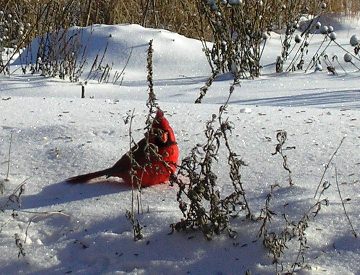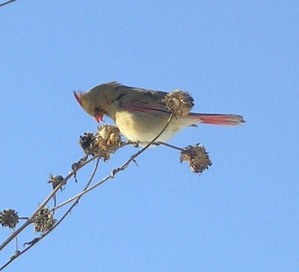A bright color of Husker Red in the midst of a dull brown and white landscape is a sure sign a male Northern Cardinal (Cardinalis cardinalis) is visiting your acreage. Northern Cardinals are midsize song birds in which males are bright red and females are rusty olive- grey. Both genders have the typical head crest, and dark (black on males) face mask. The cardinal's short conical beak is perfect for eating seeds.
Male cardinal on snowy landscapeThe Northern Cardinal prefers wind break rows and the edges of woodlots and forested riparian habitats. Acreage landscapes with trees and shrubs lining vegetative fields are favorite locations for these birds. They are commonly drawn to backyard feeders and seed-bearing plants. Seeds, grains, berries, and small fruits are the primary diet of these birds, although grasshoppers and other insects also may be taken.
In Nebraska, cardinals tend to stay within a couple of miles of where they hatched. These birds do not migrate. A male uses a song to set up territory and attract females; unlike most song birds, female cardinals also engage in vocalizations. Data indicates the females may be calling upon males to bring food to the nesting site.
Northern Cardinals will aggressively protect their territory. Many homeowners have experienced male cardinals defending against their reflections in window glass, or even side mirrors on vehicles. White washing or any method that curtails exterior reflections will prevent this defensive behavior.
Female cardinal feeding on wild sunflowerA pair of Northern Cardinals usually produces and cares for two clutches of fours eggs annually. Nests are commonly built with twigs and bark in shrubs and vining bushes. The nests are typically a half sphere shape and placed about 5 to 10 feet above ground.


